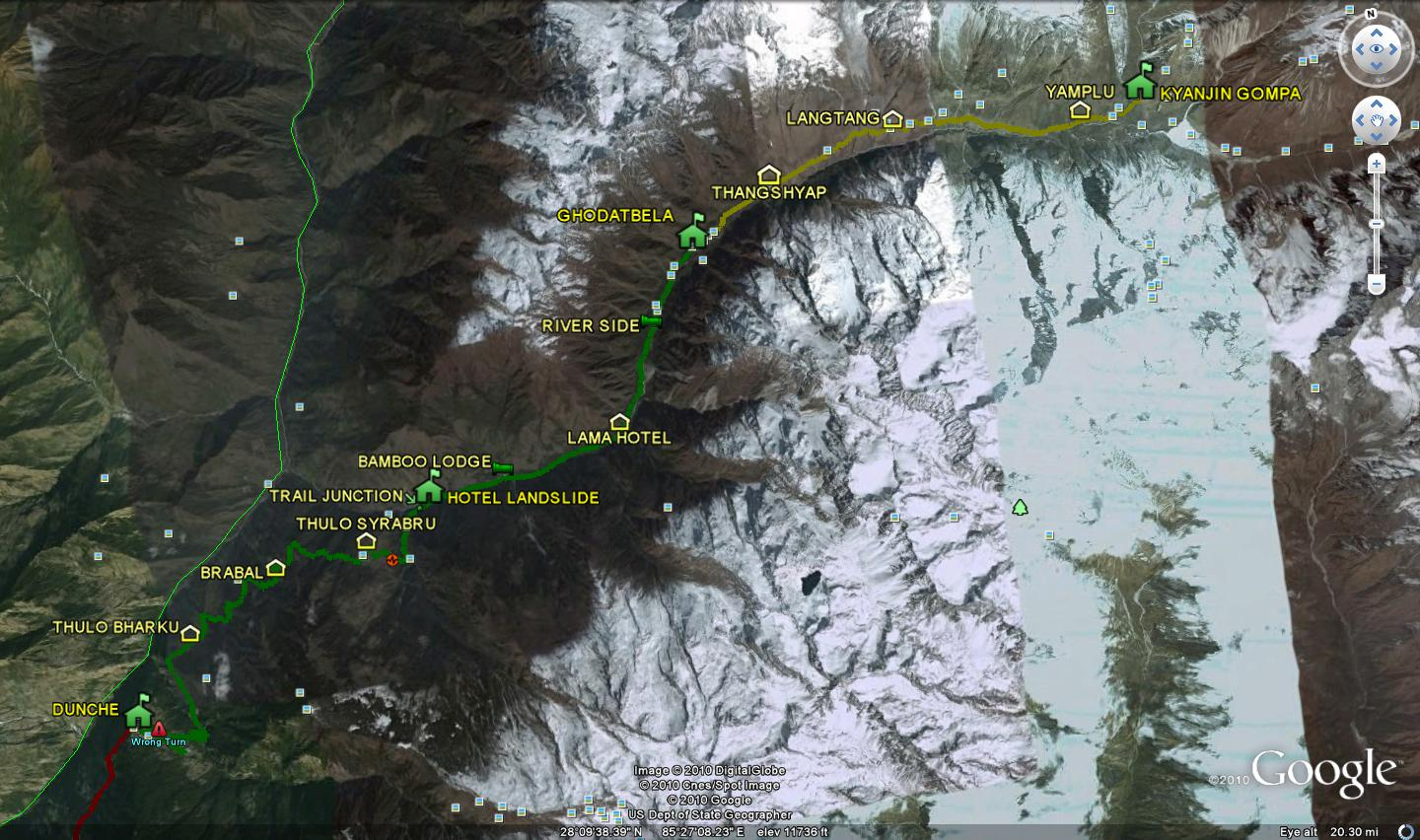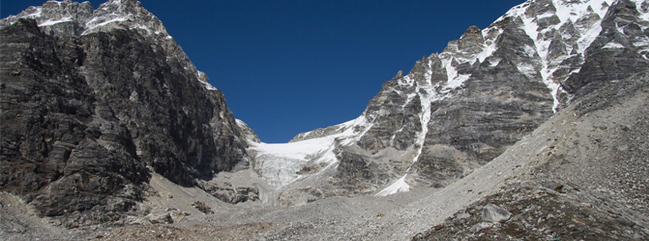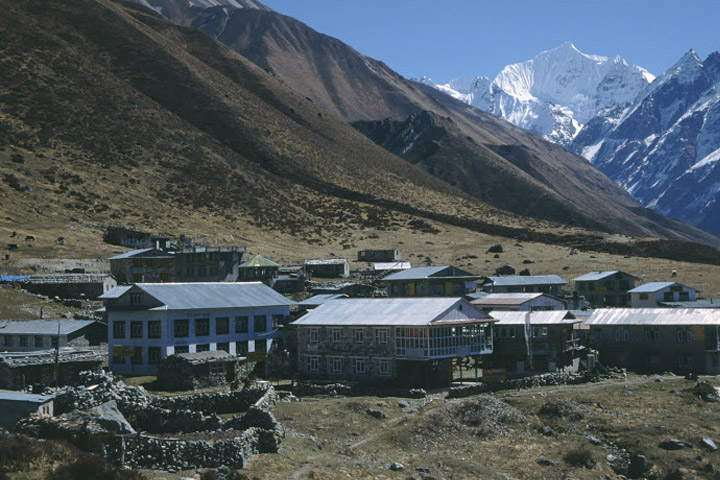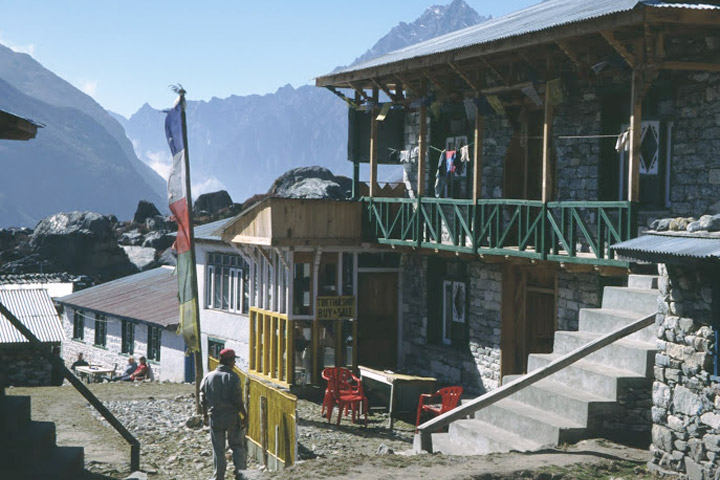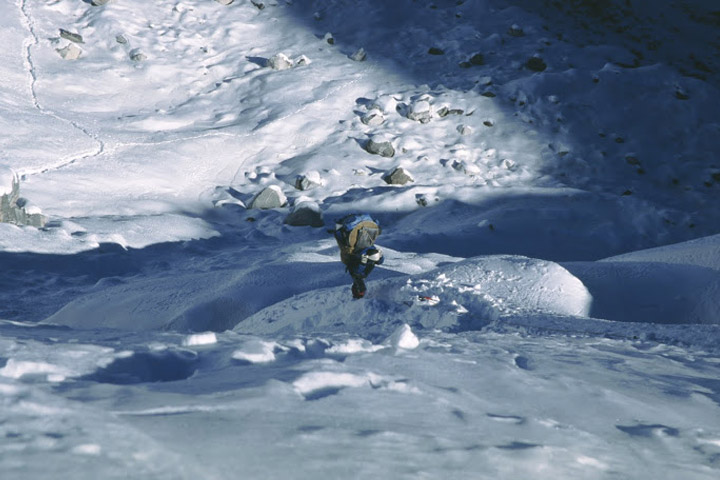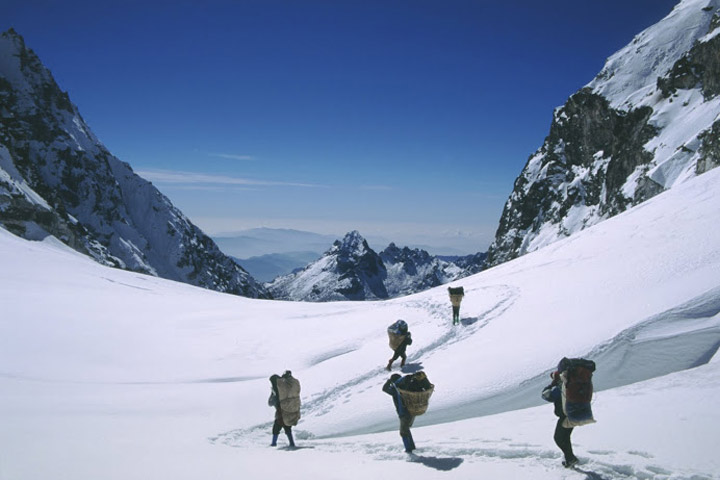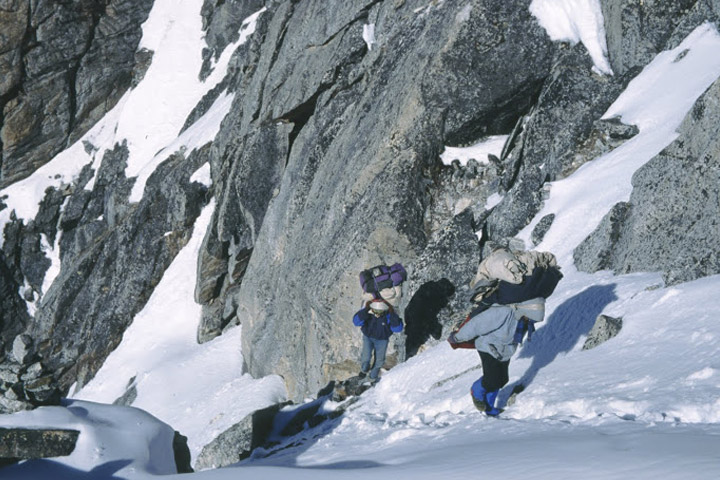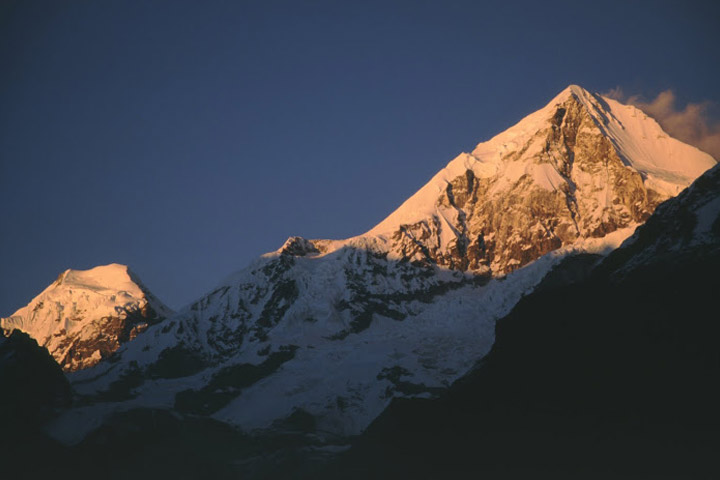Langtang Tilman Pass trekking we drive through ripe, golden-yellow, paddy fields and lush sub-tropical vegetation to the road head at the Tamang village of Chautara. Or we can start from Syabrubesi and end it at Chautara. Langtang Tilman Pass walk is also known as the Jugal Panch Pokhari trekking – a set of five small lakes – ensconced in a vast boulder-strewn amphitheatre, where we encamp near the small temple to Vishnu, a place of pilgrimage for local Hindus from the surrounding Helambu region but presently deserted. Langtang Tilman pass trekking trail is famous trekking trail for the Superb Himalayan scenery including the Langtang, Gaurishanker, and Rolwaling Himalaya range.
Langtang Tilman pass trekking connects with two different Himalaya region including the Langtang and Panch pokhari (Five holy lake) where you will enjoy and see panoramic Himalayan views of Langtang and Lirung, Langtang Himal, Naya Khanga, Yala peak, Ganesh Himal, Langshisa, Gaurishanker, Dorjelakpa etc and also green forest with Rhododendron flowers, pine tree plus wild animals /birds such as Mountain Thars,Bears, Leopard, Jackal, Monkeys, wild peaks, pheasant, peacock and holy five lake add extra romance for the trekkers. Langtang Tilman pass trekking is less crowed for the trekkers who have entire desire of enjoying with nature in the remote area.
Langtang Tillman Pass Trekking gives you different region Himalayan views, almost relaxing with High passes Himalaya range, living style of rural people and shares their culture. Langtang Tilman pass trekking begins at syabrubesi which is one of the popular trekking trails of Langtang region and end at Chautara closed to the Bhotekosi River. Grade of trekking is Moderate to strenuous. Highest access of the Langtang Tilman Pass Trek is (5350 meters). Langtang Tilman Pass trekking offers you mixed culture; Bramin, Chhetri, Tamang Tibetan Sherpa. Possible Himalayan sights in Langtang Tilman Man Pass walk are Langtang Himal, Gaurishanker, and Dorje lakpa etc .Splendid breathtaking place: production Method of cheese and relaxing with mixed culture.
Day 01: Arrive at Kathmandu
Upon arrival at international airport meet assist and transfer to the Hotel (star category, very nice and centrally located at Thamel), take rest and free at afternoon.
Day 02: Kathmandu Valley Sightseeing pre- Treks (1350m)
Our Tour Guide led you explore around Kathmandu valley for the sight seen. Have explore historical and spiritual attractions; including the historic Kathmandu Durbar Square; the House of Living Goddess “Kumari” and Kasthamandup temple” Said that was built from single tree in 16th century, Big bell-Big drams, Erotic carving in old temple, old palace etc., Bouddhanath; one of the largest Stupas in Nepal, Swayambhunath; situated on top of the hill knows as the Monkey Temple is one of the oldest Buddhist Stupa in the world, which has been registered in UNICECO heritage side. Pasupatinath; Hindus holy place, Sadhus and pilgrims bathing at occasionally, funeral pyres burning on the Ghats, located on the holy Bagmati river. Finally we have sightseeing beautiful Patan Durbar squares; the Krisna Temple has build just by stone with incredible crafts, Patan king’s palace, Golden temple and much more. It is very famous for woodcarving, Metal works, Temples and Monasteries. If we have time there are still more remark site; the one of the oldest cities in Kathmandu valley “Bhaktapur” is known as Living Museum. Where, old brick paved enclave of old Royal palace, Nyathapola Temple, Datatriya temple exquisite artwork offers a picture of the grandeur of medieval Nepal. After these activates back to hotel and pre- prier for the treks. Stay overnight at hotel. Please, check your insurance details and have a copy of your travel medical insurance policy with you.
Day 03: Drive Kathmandu to Syabrubesi (1440m) -7 to 8 hours
Our Guide and Potter come to in your hotel at 6:00 am. Then we head north out of Kathmandu to Syabru Besi about 7/8 hours scenic driving by bus or Land cruiser (depending on group size). The scenery of foothills and ridgeline vistas to Syabru Besi goes through the Trishuli Bazaar, Betrawati and Dhunche you feel as if you are heading towards deep land. While passing along the road at the bank of Trishuli River you catch a glimpse of Ganesh Himal, terraces and green hills. Behind Trisuli Bazaar the road is tricky because of the grubby road. Stay overnight at hotel.
Day 04: Trek Syabrubesi to Lama Hotel (2,470m) -5 to 6 hours
As a first day of trekking, we are exciting; the first part of the trail crosses through Bhote Koshi and follows the Langtang Khola and gradually climbs to Bamboo (1960m) enjoy through the rhododendron and bamboo forests. The variety wildlife; yellow-throated martens, wild boars, langur monkeys, red pandas and Himalayan black bears etc. are inhabitance of this forest. Afterwards, your trek ascends gently to Rimche (2400m) through Bamboo which lies at the bank of Langtang Khola with few houses. Probably, we will have lunch at this place if you like. And at the end your trail is level to the Lama Hotel for the overnight stay.
Day 05: Trek Lama Hotel to Langtang (3,430m) -5 to 6 hours
Today, at the beginning the trail climbs up towards a steep forest slope to the Langtang River. The trail follows Gumanechok, Ghoda Tabela literally it means the Horse Stable. After this the trail is slightly gradual and beautiful in the valley with the grazing Yaks. After sometime descends into a valley, the trail cross a stream and climbs past several water-driven prayer wheels to the large settlement of Langtang. This is one of the old villages along this trekking route and the view from here is more spectacular as we get closer to mountain. Rest of the day we walk around village and stay overnight Guest house.
Day 06: Trek Langtang to Kyanjin Gompa (3,870m) -3 to 4 hours
The trail leads us through the tiny village, stone-built houses and climb to a Chorten and passed a huge mani along a gentle path of a hill. We have chance to test cheese and curd by Yak milk, it is remarkable of this place. This is a shorter walk but enough for acclimatization. The surroundings are interesting also because of the famous Cheese factory. This beautiful valley is in the lap of the Langtang Lirung and others around us. This is a good place to explore local culture similar as Tibetan which has been dragging from centuries.
Day 07: Explore Day in Kyanjing Gumba
Today is a day to rest and explore around. We visit the monastery and the cheese factory or may walk up the moraine to see the spectacular ice faces and tumbling glaciers of Langtang Lirung or ascend Kyangjin Ri (4350m) and Tserko Ri (5,000m), which is highest point of this trek, directly behind the village, for a breath-taking panorama of the langtang Lirung, Langtang range, Kinshung, Yansa Tsenji and the foot of the huge Lirung Glacier. Descend to guesthouse for overnight.
Day 08: Trek Kyanjin Gomp to Langshisa Kharka (4100m) -5 to 6 hours
Today is exciting day for non tourist area trekking and more adventures. We will trek from Kyanjin Gompa to Langshisa Kharka which is situated at the height of 4100m. It will take about 5 to 6 hours to arrive here from Kyanjin Gompa. Stay overnight at tented camp.
Day 09: Trek Langshisa Khara to Moraine Camp (4650m) -5 to 6 hours
It is another factice through the high alpine vegetations and pure of nature. We will trek to Moraine Camp which is situated at the height of 4650m and it is one of the highest points of our trekking. Today trek is about 6 hours and more depending upon the speed you make. Stay overnight at camp.
Day 10: Trek Moraine Camp to Tilman Pass Base Camp via Tilaman Pass (5320m) -6 to 7 hours
This is most exciting and strenuous journey. After breakfast, the trail leads us Tilman Base Camp via Tilman Pass which is situated at the height of 5320m. Mostly the trek goes steeply up through the rocky moraine and descends another side for overnight stay at tent.
Day 11: Trek Tilman Base Camp to Tinpokhari (3735m) -5 to 6 hours
After breakfast, we will begin our journey for today destination Tinpokhari (the three lakes) which is one of the major attractions of the Langtang Tilman Pass Trekking. The trek takes 6 hours to arrive in Tin Pokhari from Tilman Base Camp. Stay overnight in tented camp with hot food.
Day 12: Trek Tinpokhari to Panchpokhari (4123m) -5 ½ to 6 hours
After breakfast, we will start today trip to tranquil Lake Panchpokhari which is situated at 4123m elevation. The bueatiy of here is incredible. Stay overnight at Panchpokhari camp.
Day 13: Panchpokhari excursion day
After late weak up and have hot breakfast we will wonder around Panchpokhari and nature excursion. This eye-catching setting is a secluded pilgrimage site where the Janaipurnima festival is held in August. Many Hindu and Buddhist pilgrims visit this lake each year and we can see two pilgrim houses and the temple dedicated to Lord Shiva. Stay overnight at camp.
Day 14: Trek Panchpokhari to Nasimpati (3745) -5 to 6 hours
Today, our trip will over about 5/6 hours normal walking. The trail leads us gradual descent through rocky hills to reach our destination of Nasimpati for tented camp overnight. Rest of the day we will enjoying mountains view and surrounded nature beauties.
Day 15: Trek Nasimpati to Bhangyang (3414m) -5 to 6 hours
At the begging today trip, we enjoy the gradual ascent through rocky hills and rhododendron forest. Then we take it easy on the steep downhill section at the final day. It takes about 5/6hours to get in Bhangyang. From our camp site you can relax and enjoy the stunning mountain views, or if you like to explore, you can gain some insight into the culture and daily life of the village.
Day 16: Trek Bhangyang to Pauwabas (3024m) -5 to 5 ½ hours
Our guide and staff will wake you up early in the morning for breakfast and to let you know to get ready for today destination Pauwabas. We have some great mountain views on our way down into our camp at Hille Bhanjyang then we start to ascend through the forest. Before reaching Pauwabas the trail lead steeply down. In Pauwa Bas there is a shelter for pilgrims to Panch Pokhari.
Day 17: Trek Pauwabas to Kharka (2855m) -5 to 6 hours
We will have breakfast in Pauwabas as usual time and our guide will brief all about the area and its people, culture and history along the way of coming trail. Today’s walk is nice and gentle, being fairly level (‘Nepali flat’) and we can enjoy our forest trails and wildlife spotting. We have about 5 to 6 hours through the lush forest of rhododendron, oak, pine and juniper and we can see some nomad’s houses for cattle on the way.
Day 18: Trek Kharka to Okhreni (2043m) -4 to 5 hours
The trail from here we get into solve descend through stunning, dense Rhododendron and pine forest. And then gently walk downhill to the Okhreni. If we are lucky and observant, we might spot some wild animals such as mountain deer or langur monkeys and Nepali birdlife like the danfe. We spend overnight here with regular activities. We camp at Sano Okhareni near a pine forest and with great views to the mountains!
Day 19: Trek Okhreni to Chautara (1235m) -5 to 6 hours
Today is our last trekking day in beautiful land with different vegetation and people live hood. About 5/6 hours of gradual downhill walking we get in Chautara. The trail goes through small villages where we can see how the diverse ethnic groups live side by side. We set our camp near by Chautara bazzar. We will celebrate trekking last night with Nepalese drum and popular flock song.
Day 20: Drive Chutara by private vehicle via /Bus drive back to Kathmandu -4 to 5 hours
This morning we have a beautiful drive to Kathmandu. We get here by 2 o’ clock and then we go to Hotel for the rest. We will drive back to Kathmandu through the road passing terraces, streams, rivers, local settlements, high hills and along the river side. It takes about 4 to 5 hours (conditional) to reach your hotel in Kathmandu by bus/ private car.
Day 21: Farewell friend day in Kathmandu (1,350m)
In this pleasant day you may have full day at leisure either relax at hotel or explore the around Thamel. Today is day of ending your journey, so we would like offer you farewell dinner in Nepali typical Restaurant and hand over you Trip Certificate, Trekking Permit and TIMS Card for memory of Nepal trip.
Day 22: final Departure to your Destination
Today is free or last minute shopping for souvenirs or gift to your family, friends or relatives for you until departure flight/drive. Our assist will be transfer to the International Airport for your departure flight to your onwards destination.
NOTE: The above information is a guide and standard template of what we provide. The trek can be customized at your request to accommodate your specific requirements.
Note : On adventure trips of this type, weather, local politics, transport or a multitude of other factors beyond our control can result in a change of itinerary. It is, however, very unlikely that the itinerary would be substantially altered; if alterations are necessary the leader will decide what is the best alternative, taking into consideration the best interests of the whole group. Where a change does occur, we do everything we can to minimize its effect, but we cannot be responsible for the results of changes or delays.
Q.What type of shape do I need to be in, is this trip for me?
A. Trekking is suitable for average people who are moderately fit, thus no previous experience is required. Some physical fitness programs such as running, swimming, hiking is recommended before you embark on your journey. Persons suffering from a pre-existing medical condition or disease must seek medical advice before considering the trek. Whilst on the trek, it is common to experience some discomfort before being fully acclimatized.
To prepare for a strenuous trek you should begin training at least two to three months before your departure. As a guideline, an hour of aerobic exercise three to four times per week would be considered a minimum requirement. The best preparation is bushwalking involving relatively steep ascents and descents. If you can manage a couple of valley floor to ridgeline ascents per comfortable and able to enjoy the trek to the fullest. They are physically strong, sharp-witted and have an incredibly positive attitude towards a life that we would consider extremely tough. There is something about a trek in the Himalaya that draws you back time and time again. For keen walkers it is a paradise and even avowed non-walkers find that one foot just seems to follow the other, drawn by the appeal of what lies beyond.
Q. Will somebody come to pick me up at the Airport upon my arrival?
A. Yes, our Airport Representative will be there to greet you outside of Terminal Hall, he/she will be displaying an Kiwi Adventures Treks & Expedition sign board. Upon arrival, you will be transferred to your hotel.
Q. What sort of accommodation can I expect in Kathmandu and in trekking?
A. 11 night’s Trekking Guesthouse, 4 nights three/four star hotels in Kathmandu.
We use standard rooms from three/four star hotels in Kathmandu with breakfast included. Along the trekking routes teahouses/Lodges generally provide basic clean facilities with a mattress and a quilt or blanket. We can also offer you sleeping bags if needed (which need to return after the trip) but it is a good idea to always have your own sleeping equipment. We usually provide single and double rooms as well as the occasional dormitory. The dining room is downstairs around a fire. All food will be cooked to order in the little kitchen. You should not enter the kitchen unless asked to do so.
Q. What sort of food can I expect in trekking?
A. In trekking most teahouses (lodges) cook a delicious range of mostly vegetarian fare. Pasta, tuna bakes, noodles, potatoes, eggs, dhal bhat, bread, soups, fresh vegetables (variety depends on the season) and even some desserts like apple pies, pancakes, and some interesting attempts at custard. You will find a lot of garlic on the menu because it assists with acclimatization – eat some every day. In many larger villages you may find some meat on the menu. You can always get hot chocolate, tea, and hot lemon drinks, as well as soft drinks, and treats like chocolate and crisps.
Each day dinner and breakfast are used to take in the same lodge you spend the night. Lunch will be taken on the way to destination.
Q. What sort of transportation you use?
A. Kiwi Adventures Treks & Expedition is all about providing you with local insights as well as adventure, with that in mind, where we think you will get more out of your holiday by using different means of transport that is what we do. Using a variety of private transport is an integral part of our Himalaya tours and enhances the experience!
We use private tourist vehicles for sightseeing, city tours and pickups. Depending on the group size we use cars, minibus, van or land cruiser. These small light vehicles are more manoeuvrable and flexible enabling us to take you through the Narrow roads of Nepal. All the vehicles are usually air-conditioned unless we are travelling in cooler areas.
Q. What is the best season for this trekking?
A. Our trekking season extends from mid- September to May. From early September the monsoonal rains decrease. By end of September through to December the weather is usually stable with mild to warm days, cold nights. February, March, April, May, October, November, December are the best time to do trek.
Q. What is the weather & temperature like in trekking?
A. Weather in the mountains is notoriously difficult to predict. At night it is generally cooler the days are generally warm. Winter (January and February) will be bit colder but the days can be quite beautiful and warm if the sun is out. There will be bit of snow during the month of January, February and December. It is also important to make sure that you can stay warm and dry in just about any conditions. Expect the unexpected! The temperature could be as high as 20 deg C to -15 deg C low.
Q. Can I charge my digital camera or other batteries on my trip?
A. These facilities will be available in most of the places in your hotel reception by paying some service charges. Remember to bring your adapters!
Q. Is there any communication while we are on trekking?
A. There are telephones in some villages along the trekking routes from which you can make international calls.
Q. Can I use credit cards in the places visit in trekking?
A. In most cities yes, to some extent, however once you leave those cities behind, all you need is cash.
Q. How much additional money do I need per day?
A. In Kathmandu, you can allocate US$ 10 – 25 for a lunch / dinner. It’s all depends on your spending habits. US$7 to 10 US$ a day will be enough to buy bottles of water, chocolates and few drinks in trekking.
Q. Do I need to tip my guide and porters? How much would that be?
A. This is a difficult thing to gauge. We have seen everything from 20USD to 1000 USD per person for guides and porters. Tipping is not required, but a small way to show your guides and local porters thanks for their help. The level of the tip should reflect the level of personal involvement with your guide.
Q. Is the water OK to drink? Do I need to bring purifying tablets/filter?
A. In most places bottled water is readily available. If you wish to drink normal water, you need to use purifying aid, which you will need to bring with you.
Q. Are the Kiwi Adventures Treks & Expedition staff insured?
A. Our company insures all our trekking staff, including guide, cook, sherpa and porters.
Q. What essential documents do I need to bring with me on tour?
A. *Valid Passport – must be valid for up to 6 months after you return from your tour, keep a separate photocopy.
*Travel insurance, keep a separate photocopy
*Cash and Traveller’s Cheques, keep numbers and proof of purchase separate
*Flight tickets
*Emergency contact numbers for T/C’s, banks, insurance, family contacts.
Q. Can I add extra days to my trekking trip?
A. A hoilday should never be about making it to the final point quickly. Along your trek we can add days at your request with additional costs to cover guides, porters, accommodation and food.
Q. Do you use yaks/porters on the trek or do we carry all of our own gear?
A. Whilst on the trek, our porter will take care of your luggage. All you need to carry is your small day bag for your personal belongings like camera, water bottle, sun cream etc only.
Q. What opportunities will I have for shower along the trek?
A. In major places, we arrange guesthouse with hot shower. And in rest of the places, hotel water in bucket will be provided for shower; it would cost you extra about USD 3-4 per shower.
Q. Do you know about how many total miles the trek is?
A. Total distance of the entire trek is about 75 miles.
Cost Includes
• Airport / Hotel / Airport pick up & drop by private car / van / bus.
• Heli Charter till Ghoda Tabela
• Standard accommodation in four/five star hotel in Kathmandu breakfast included.
• Guided city tour in Kathmandu by car / van / bus.
• Sightseeing/Monuments entrance fees in Kathmandu.
• All your standard Meals (breakfast, lunch and dinner) during the trek.
• Best available Lodges, Guesthouses accommodation during the trek (mainly in twin sharing).
• A local government licensed English speaking Guide during the trek.
• The required number of staff and Porters to carry your luggage during the trek.
• Food, accommodation, salary, insurance, equipment, medicine and transportation for all trekking/tour staff.
• Langtang National Park permits.
• First aid medical kid.
• Surface transfer from and to Kathmandu.
• All our government taxes.
• Official expanse.
Cost Excludes
• Lunch and dinner whilst in Kathmandu.
• Your travel insurance (compulsory).
• International airfare and airport departure tax.
• Nepal entry visa fee (US$ 30 per person) you obtain a visa easily upon your arrival at Tribhuwan International Airport Kathmandu for 60 days from date of issue. You will require 2 passport size photos.
• Alcoholic, hot and cold drinks, laundry.
• Personal trekking Equipments.
• Tips for trekking staff. (Tipping is expected).
• Any others expenses which are not mentioned on Price Includes section.
